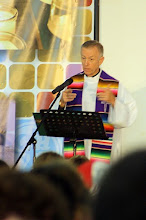
Traditionally (and famously depicted in the Last Judgment in the Sistine Chapel), St. Bartholomew was martyred by being flayed alive—Michelangelo has him holding his skin!
But this Christmas season (aka, prime new movie holiday season) there is expected the release of #3 of The Chronicles of Narnia: The Voyage of the ‘Dawn Treader.’ Lord knows that most Christianity has been emasculated from these movie ‘versions’ of the books, and since there is so much Christian symbolism in VDT it’ll be interesting to see how they present the original story-line without its content—especially in a pivotal scene related to today’s feast.
The new “star character” is a boy named Eustace Clarence Scrubb—“and he almost deserved it,” Lewis says in the opening sentence of this book. [FYI: the author was actually “Clive Staples Lewis,” so he knew the burden of a bizarre name. From age 4, he insisted on being called “Jack,” and who could blame him?]
Turned into a dragon by his greed and laziness, he undergoes a conversion of heart that leads him to encounter Aslan, the Lion who (in the books, at least) is the Christ-figure of the Narnian world. In order to heal Eustace, Aslan must “undress” the dragon—rip off all the scaly ‘clothing' and bring him back to boyhood again. It works, but only after 5-6 layers of skin have been torn away.
Both Bartholomew and Eustace experience the need to shed all the remnants of our sinful existence in order to be born again. What layers of ‘skin’ do we need to shed (or have torn from us)?
Even when this happens, though, we must remember we are still beings in process—“God isn’t finished with me yet,” as the old saying goes. Lewis is a bit more specific with Eustace:
It would be nice, and fairly nearly true, to say that “from that time forth Eustace was a different boy.” To be strictly accurate, he began to be a different boy. He had relapses. There were still many days when he could be very tiresome. But most of these I shall not notice. The cure had begun.
Do we want the cure to begin (or continue) in us? Are we ready/willing to persevere even when we have relapses? Can Eustace and Bartholomew inspire us with the insight that the old self, when stripped away, leaves a new and blank slate for God to draw us anew? What a joy, to see the old garbage gone! What a hope, to know that “the cure [has] begun”!
But this Christmas season (aka, prime new movie holiday season) there is expected the release of #3 of The Chronicles of Narnia: The Voyage of the ‘Dawn Treader.’ Lord knows that most Christianity has been emasculated from these movie ‘versions’ of the books, and since there is so much Christian symbolism in VDT it’ll be interesting to see how they present the original story-line without its content—especially in a pivotal scene related to today’s feast.
The new “star character” is a boy named Eustace Clarence Scrubb—“and he almost deserved it,” Lewis says in the opening sentence of this book. [FYI: the author was actually “Clive Staples Lewis,” so he knew the burden of a bizarre name. From age 4, he insisted on being called “Jack,” and who could blame him?]
Turned into a dragon by his greed and laziness, he undergoes a conversion of heart that leads him to encounter Aslan, the Lion who (in the books, at least) is the Christ-figure of the Narnian world. In order to heal Eustace, Aslan must “undress” the dragon—rip off all the scaly ‘clothing' and bring him back to boyhood again. It works, but only after 5-6 layers of skin have been torn away.
Both Bartholomew and Eustace experience the need to shed all the remnants of our sinful existence in order to be born again. What layers of ‘skin’ do we need to shed (or have torn from us)?
Even when this happens, though, we must remember we are still beings in process—“God isn’t finished with me yet,” as the old saying goes. Lewis is a bit more specific with Eustace:
It would be nice, and fairly nearly true, to say that “from that time forth Eustace was a different boy.” To be strictly accurate, he began to be a different boy. He had relapses. There were still many days when he could be very tiresome. But most of these I shall not notice. The cure had begun.
Do we want the cure to begin (or continue) in us? Are we ready/willing to persevere even when we have relapses? Can Eustace and Bartholomew inspire us with the insight that the old self, when stripped away, leaves a new and blank slate for God to draw us anew? What a joy, to see the old garbage gone! What a hope, to know that “the cure [has] begun”!

No comments:
Post a Comment